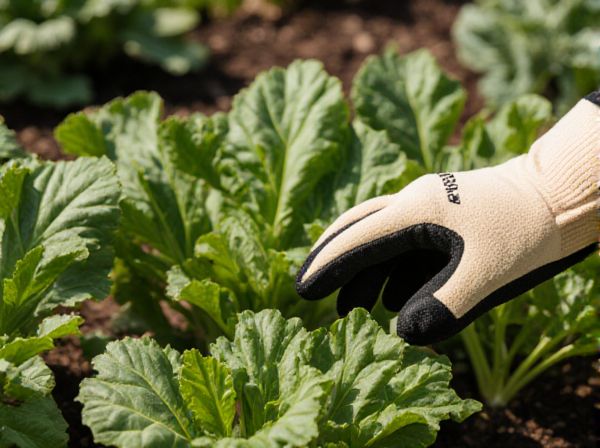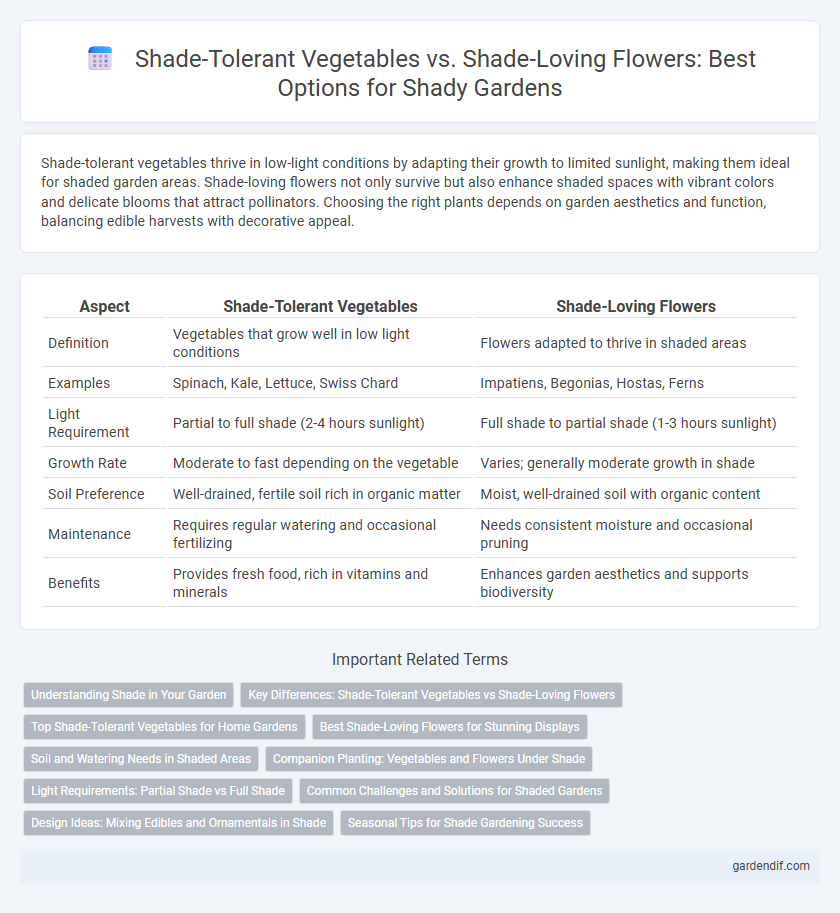
Shade-Tolerant Vegetables vs Shade-Loving Flowers Illustration
Shade-tolerant vegetables thrive in low-light conditions by adapting their growth to limited sunlight, making them ideal for shaded garden areas. Shade-loving flowers not only survive but also enhance shaded spaces with vibrant colors and delicate blooms that attract pollinators. Choosing the right plants depends on garden aesthetics and function, balancing edible harvests with decorative appeal.
Table of Comparison
| Aspect | Shade-Tolerant Vegetables | Shade-Loving Flowers |
|---|---|---|
| Definition | Vegetables that grow well in low light conditions | Flowers adapted to thrive in shaded areas |
| Examples | Spinach, Kale, Lettuce, Swiss Chard | Impatiens, Begonias, Hostas, Ferns |
| Light Requirement | Partial to full shade (2-4 hours sunlight) | Full shade to partial shade (1-3 hours sunlight) |
| Growth Rate | Moderate to fast depending on the vegetable | Varies; generally moderate growth in shade |
| Soil Preference | Well-drained, fertile soil rich in organic matter | Moist, well-drained soil with organic content |
| Maintenance | Requires regular watering and occasional fertilizing | Needs consistent moisture and occasional pruning |
| Benefits | Provides fresh food, rich in vitamins and minerals | Enhances garden aesthetics and supports biodiversity |
Understanding Shade in Your Garden
Shade-tolerant vegetables such as spinach, kale, and lettuce thrive in areas receiving 3-6 hours of filtered sunlight, making them ideal for shaded garden spots where sunlight is limited but present. Shade-loving flowers like impatiens, begonias, and fuchsias flourish in dappled or deep shade, typically requiring less direct light and more humidity. Understanding the specific light requirements of these plants helps gardeners optimize growth, ensuring vegetables receive enough indirect light for photosynthesis while ornamental flowers benefit from cooler, shaded environments to prevent leaf scorch.
Key Differences: Shade-Tolerant Vegetables vs Shade-Loving Flowers
Shade-tolerant vegetables such as spinach, kale, and lettuce adapt by requiring indirect sunlight for photosynthesis, thriving in partial shade environments. Shade-loving flowers like impatiens, begonias, and fuchsias flourish in low light by maximizing light absorption through larger leaves and specialized pigments. The primary difference lies in their biological function and growth requirements: vegetables prioritize leaf development for edible yield, while shade-loving flowers focus on blooming and reproductive success under shaded conditions.
Top Shade-Tolerant Vegetables for Home Gardens
Top shade-tolerant vegetables ideal for home gardens include leafy greens like spinach, kale, and Swiss chard, which thrive in low-light conditions and provide high nutritional value. Root vegetables such as beets and radishes also perform well in shaded areas, making efficient use of limited sunlight to develop flavorful crops. These vegetables contribute both diversity and resilience to home gardens where sunlight is constrained by shade-loving flowers or surrounding structures.
Best Shade-Loving Flowers for Stunning Displays
Shade-loving flowers like impatiens, begonias, and astilbes thrive in low-light conditions, creating vibrant and colorful garden displays where sunlight is limited. These flowers exhibit lush foliage and abundant blooms, making them ideal for enhancing shaded areas such as patios, under trees, or in north-facing garden beds. Selecting shade-tolerant species ensures consistent growth and stunning floral arrangements that brighten otherwise dim garden spaces.
Soil and Watering Needs in Shaded Areas
Shade-tolerant vegetables, such as spinach and kale, require well-drained, nutrient-rich soil with consistent moisture to thrive in low-light conditions. Shade-loving flowers like impatiens and begonias prefer moist, humus-rich soil that retains water without becoming soggy, supporting delicate root systems in shaded environments. Both plant types benefit from careful watering schedules to prevent fungal diseases common in shaded, damp areas.
Companion Planting: Vegetables and Flowers Under Shade
Shade-tolerant vegetables like spinach, kale, and lettuce thrive in low-light conditions and benefit from companion planting with shade-loving flowers such as impatiens, begonias, and fuchsias, which help repel pests and enhance growth. Integrating these plants in shaded garden areas optimizes space and improves microclimates by maintaining moisture and reducing temperature fluctuations. Strategic pairing enhances pollination and supports biodiversity, promoting a healthy, balanced ecosystem under shade.
Light Requirements: Partial Shade vs Full Shade
Shade-tolerant vegetables, such as spinach and kale, thrive in partial shade, requiring about 3 to 6 hours of filtered sunlight daily to perform photosynthesis efficiently. Shade-loving flowers like impatiens and begonias prefer full shade conditions where direct sunlight is minimal or absent, typically less than 3 hours of indirect light per day. Understanding these distinct light requirements is crucial for optimizing plant growth and ensuring healthy development in shaded garden areas.
Common Challenges and Solutions for Shaded Gardens
Shade-tolerant vegetables like spinach and kale require careful attention to soil fertility and consistent moisture to thrive in low-light conditions, while shade-loving flowers such as impatiens and begonias demand similar care but benefit from enhanced airflow to prevent fungal diseases. Common challenges include limited sunlight reducing photosynthesis, leading to slower growth and increased susceptibility to pests. Solutions involve selecting appropriate plant varieties, improving soil quality with organic matter, and optimizing spacing to maximize light exposure and airflow in shaded garden areas.
Design Ideas: Mixing Edibles and Ornamentals in Shade
Integrating shade-tolerant vegetables like spinach, kale, and Swiss chard with shade-loving flowers such as impatiens, begonias, and fuchsias creates a visually appealing and productive garden design. This combination maximizes space and enhances biodiversity by blending edible greens with vibrant blooms in mostly shaded areas. Strategic planting patterns, including layering taller vegetables behind low-growing flowers, optimize light use and aesthetic balance in shaded garden beds.
Seasonal Tips for Shade Gardening Success
Shade-tolerant vegetables such as spinach, kale, and lettuce thrive in low-light conditions during spring and fall, maximizing cooler temperatures and moisture availability. Shade-loving flowers like impatiens, begonias, and fuchsias bloom vibrant colors in summer while adapting to filtered sunlight and high humidity environments. Seasonal success in shade gardening depends on selecting appropriate plant varieties and adjusting watering schedules to account for reduced evaporation under shaded canopies.
Shade-Tolerant Vegetables vs Shade-Loving Flowers Infographic

 gardendif.com
gardendif.com